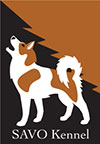



Living with a Norrbottenspets
I fell in love with the breed in 2005 and there has been no looking back since. Having had numerous northern breeds throughout my life was very comfortable and wanting the familiar independent personality that came with ownership. This breed is athletic and at home in the woods; an absolute requirement for us as we spend our leisure time hiking, mountain biking, backcountry skiing, and hunting. Norrbottenspets has been an excellent match for us.
Our first Norrbottenspets soon taught us about the breed’s bold, adventurous, and feisty personality; somewhat aloof to strangers, but very loyal and loving with their family. The dogs also have the ability to take all in stride. I’ve hauled my dogs to conformation shows, obedience trials, tracking events, flown them across oceans, and taken them on hunting trips. They definitely prefer some excursions more than others, but they deal with them all quite well. Their demeanor is pretty much rock solid.
If you are interested in having a dog of this breed as part of your life, we suggest you research independently. The dog fits in well with our lifestyle but may not work as well with others.
As with any hunting breed, the dogs need exercise. We run our dogs off-leash at least four times a week, usually on a mountain bike ride or hike, in addition to shorter walks throughout the week. A priority of ownership is understanding that these dogs are athletic and deserve an active lifestyle beyond a simple walk. Alternatives for shorter walks could be longer leashed walks, leashed jogging, or tethered-biking. Mental stimulation is important as well – agility, obedience, or Rally have all been successfully done by many dogs of this breed. Activity is the key to keeping them happy.
Norrbottenspets also has a hunting style which involves barking at the quarry. This means they will find grouse or quail, tree the bird and bark to indicate where they and the bird are. Our dogs come directly from a long line of very qualified Finnish hunting dogs which are rated on the persistence of treeing and hunt drive.
If you want such a dog for hunting, research the hunting regulations for your region. Contact your local wildlife officer or conservation officer for clarification of the rules. Every province and state has different interpretations of what dogs are allowed to do. In British Columbia, where Savo Kennel resides, we are fortunate in having quite liberal hunting regulations.
These Scandinavian bird hunting dogs have been selectively bred to range away from their human hunting partner – on average 200 to 300 meters [220 to 330 yards], and even distances of 800 m [½ — ¾ mile] are not unheard of especially when following a strong scent. According to hunters’ theories, the larger the search area, the greater the chance of finding a bird. Be sure you can also tolerate the roaming hunt style of this breed.
Young dogs can be curious off-leash and should be trained to check in every 5 to 15 minutes. The periodic check-in is a necessary and scored component of a Finnish hunt trial. It is necessary, therefore, to put a recall on the dog and start training immediately. A GPS tracking collar for off-leash excursions is highly recommended.
Typically, this is not the type of dog that, when off leash, will stay by your side or always within visual range. It should be understood that the Norrbottenspets is a hunting spitz whose nature is to search and explore.
There are many small, general descriptive articles about this breed can be found online, but the best source is to talk to other breeders and meet others who have the dogs and to meet the dogs themselves. Bringing such a dog into your life is a 15-years commitment as they are a long-lived breed.
References
Suomen Pystykorvajärjestö. “A guide for new puppy owners 2008: from puppy to hunting dog.” Accessed February 14, 2013.
https://docs.google.com/document/d/1KqHosR-3B5NpI_uUufyMDZ9nsRBgIiQlydcuAhkkGw4/edit
Bob with his family.

